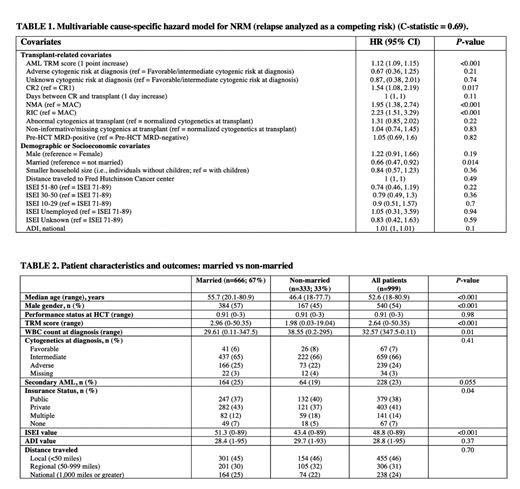Introduction: It is increasingly recognized that racial and socioeconomic disparities play an important prognostic role and contribute to differences in outcomes in adults receiving chemotherapy for acute myeloid leukemia (AML). Structural racism has also been implicated in limiting access to allogeneic hematopoietic cell transplantation (HCT). However, it is unclear to what degree racial and socioeconomic disparities impact post-HCT outcomes of patients with AML in contemporary practice. To address this uncertainty, we investigated the impact of socioeconomic, racial, and non-biologic disparities on outcomes in a large cohort of adults with AML undergoing allogeneic HCT while in first or second morphologic remission.
Methods: We identified 1,004 adults with AML (2022 ICC criteria) who underwent allogeneic HCT between 5/2006 and 10/2021 at a single large university-affiliated cancer center. Data was collected on each patient's individual socioeconomic status (SES), including occupation, insurance type, and education attainment. Distance traveled, marital status, household size, country of birth, and religious affiliation were also recorded. Each occupation was classified by the International Socio-Economic Index (ISEI), a standard index of occupational status. Area-level SES was analyzed through the Area Deprivation Index (ADI), a validated measure of socioeconomic disadvantage which corresponds to U.S. census tract measurements. Collected HCT variables include the AML treatment-related mortality score (TRM), pre-HCT flow cytometric MRD status, HLA donor status, cytogenetic risk, conditioning regimen intensity, and incidence of severe acute and chronic graft-vs-host disease. Measured outcomes include non-relapse mortality (NRM), overall survival (OS), relapse, and relapse free survival (RFS). Cause-specific hazard models were used for univariate and multivariable regression analysis and C-statistics were calculated to quantify each model's ability to predict outcomes.
Results: In univariate analysis, none of the socioeconomic or non-biologic factors were significantly associated with NRM, and all had poor predictive performance, with C-statistics not exceeding 0.53 for: marital status, larger household size (i.e., patients with children), distance traveled, ISEI, ADI, insurance status, educational attainment, or country of birth. TRM score (P<0.001), non-myeloablative conditioning (P<0.001), reduced intensity conditioning (P<0.001), CR2 (P=0.017) and marital status (P=0.014) were significantly associated with NRM in a multivariable model, but predictive performance of this model was only fair (C=0.69; Table 1). Marital status was only associated with NRM after multivariable adjustment but not on univariate evaluation, possibly because married patients were, on average, older (P<0.001), more likely to be male (P<0.001), and have higher occupational status/ISEI (P<0.001) and TRM scores (P<0.001), with age and sex as likely confounders (Table 2). African American patients (n=14) were found to have worse NRM in both univariate (P=0.036) and multivariate (P=0.024) models, consistent with previously identified racial/ethnic disparities in AML cohorts. Similar results were found for SES and non-biologic variables in regards to OS, relapse, and RFS. Notable exceptions after multivariable adjustment include: ADI was significantly associated with OS (P=0.036) and RFS (P=0.044) and marital status was not significantly associated with OS or relapse. Additional analyses demonstrated that ISEI and ADI were not associated with increased TRM or HLA donor status. Finally, distance traveled decreased in HCT recipients post-2013 (P<0.003), though the number of AML-related transplants remained unchanged.
Conclusion: In this retrospective, single center analysis, socioeconomic and non-biologic factors had very limited impact on outcomes following allografting for adults with AML. While reassuring, patients able to undergo allogeneic HCT are highly selected (e.g. need for caregiver, insurance, etc.) possibly accounting for this finding, as could integrated, multidisciplinary cancer care networks and longitudinal care coordination post-HCT. Further research is needed to investigate disparities among HCT-eligible patients and improve access to HCT with a focus on reducing racial/ethnic disparities.
Disclosures
Milano:ExCellThera Inc.: Research Funding. Sandmaier:Actinium Pharmaceuticals: Membership on an entity's Board of Directors or advisory committees. Walter:Amgen, Aptevo, Celgene, Janssen, Jazz, MacroGenics, Pfizer: Research Funding; ImmunoGen, Jura: Consultancy, Research Funding; Abbvie, Adicet, Amphivena, BerGenBio, Bristol Myers Squibb, GlaxoSmithKline, Orum: Consultancy.


This feature is available to Subscribers Only
Sign In or Create an Account Close Modal